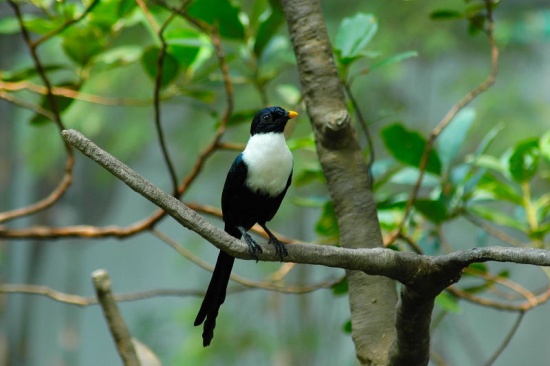m |
(completed, picture replaced) |
||
| Line 1: | Line 1: | ||
| − | {{ | + | [[Image:White-necked Myna 1 .JPG|thumb|550px|right|nominate form<br />Photo by {{user|Don+Gato|Don Gato}}<br />Flores, [[Indonesia]], October 2006]] |
| + | '''Alternative names: Buton Starling; Buton Myna; Sulawesi Magpie''' | ||
;[[:Category:Streptocitta|Streptocitta]] albicollis | ;[[:Category:Streptocitta|Streptocitta]] albicollis | ||
| − | |||
| − | |||
==Identification== | ==Identification== | ||
| − | + | 50cm (including tail 25-30cm). A large myna with a very long tail. | |
| − | + | * Black head, glossed purple, with short crest | |
| − | + | * White mantle and breast forming a broad collar | |
| + | * Black rest of plumage with steel-blue and green iridiscence | ||
| + | * Black wing with purple sheen | ||
| + | * Black, very long and graduated tail | ||
| + | * Brown eye surrounded by dark bare skin | ||
| + | * Black bill, with yellow tip in ''albicollis'' and all-black in ''torquata'' | ||
| + | Sexes similar. Juveniles have a smaller crest, a shorter tail and (in ''albicollis'') less yellow on bill. | ||
| + | [[Image:289 wn myna cr 4 sm.jpg|thumb|350px|right|ssp ''torquata''<br />Photo by {{user|martinuk|martinuk}}<br />Dumoga Bone National Park, [[Sulawesi]] Utara, [[Indonesia]], September 2009]] | ||
==Distribution== | ==Distribution== | ||
| − | [[Sulawesi]], [[Indonesia]]. | + | Endemic to [[Sulawesi]] and some adjacent islands, [[Indonesia]]. Has been recorded on Flores.<br /> |
| − | + | Poorly known but obviously widespread and common. | |
==Taxonomy== | ==Taxonomy== | ||
| − | ====Subspecies<sup>[[#References|[1]]]</sup> | + | ====Subspecies==== |
| − | + | Two subspecies recognized<sup>[[#References|[1]]]</sup>: | |
| − | *''S.a.torquata'' | + | *''S.a.torquata'' in northern [[Sulawesi]], Lembeh Island and Togian Islands |
| − | *''S.a.albicollis'' | + | *''S.a.albicollis'' in southern[[Sulawesi]], Muna and Butung islands |
| − | + | May form a superspecies with [[Bare-eyed Myna]]. | |
==Habitat== | ==Habitat== | ||
| − | + | Primary and secondary forest. Occurs from sea-level up to 1200m. | |
==Behaviour== | ==Behaviour== | ||
| + | Feeds mainly on fruit. Takes also invertebrates and sometimes small vertebrates (lizards). <br /> | ||
| + | Usually seen in small groups of two or three birds, sometimes up to five. Joins mixed-species flocks.<br /> | ||
| + | Breeding season September to October. Presumably a [[Dictionary_M-S#M|monogamous]] species. Nest in holes in dead trees. No other information.<br /> | ||
| + | Presumably a resident species. | ||
==References== | ==References== | ||
| − | #{{Ref- | + | #{{Ref-Clements6thDec09}}#{{Ref-HBWVol14}} |
| − | + | {{ref}} | |
==External Links== | ==External Links== | ||
{{GSearch|Streptocitta+albicollis}} | {{GSearch|Streptocitta+albicollis}} | ||
[[Category:Birds]] [[Category:Streptocitta]] | [[Category:Birds]] [[Category:Streptocitta]] | ||
Revision as of 08:11, 17 November 2010
Alternative names: Buton Starling; Buton Myna; Sulawesi Magpie
- Streptocitta albicollis
Identification
50cm (including tail 25-30cm). A large myna with a very long tail.
- Black head, glossed purple, with short crest
- White mantle and breast forming a broad collar
- Black rest of plumage with steel-blue and green iridiscence
- Black wing with purple sheen
- Black, very long and graduated tail
- Brown eye surrounded by dark bare skin
- Black bill, with yellow tip in albicollis and all-black in torquata
Sexes similar. Juveniles have a smaller crest, a shorter tail and (in albicollis) less yellow on bill.
Distribution
Endemic to Sulawesi and some adjacent islands, Indonesia. Has been recorded on Flores.
Poorly known but obviously widespread and common.
Taxonomy
Subspecies
Two subspecies recognized[1]:
- S.a.torquata in northern Sulawesi, Lembeh Island and Togian Islands
- S.a.albicollis in southernSulawesi, Muna and Butung islands
May form a superspecies with Bare-eyed Myna.
Habitat
Primary and secondary forest. Occurs from sea-level up to 1200m.
Behaviour
Feeds mainly on fruit. Takes also invertebrates and sometimes small vertebrates (lizards).
Usually seen in small groups of two or three birds, sometimes up to five. Joins mixed-species flocks.
Breeding season September to October. Presumably a monogamous species. Nest in holes in dead trees. No other information.
Presumably a resident species.
References
- Clements, JF. 2009. The Clements Checklist of Birds of the World. 6th ed., with updates to December 2009. Ithaca: Cornell Univ. Press. ISBN 978-0801445019.
- Del Hoyo, J, A Elliott, and D Christie, eds. 2009. Handbook of the Birds of the World. Volume 14: Bush-shrikes to Old World Sparrows. Barcelona: Lynx Edicions. ISBN 978-8496553507
Recommended Citation
- BirdForum Opus contributors. (2024) White-necked Myna. In: BirdForum, the forum for wild birds and birding. Retrieved 12 May 2024 from https://www.birdforum.net/opus/White-necked_Myna





